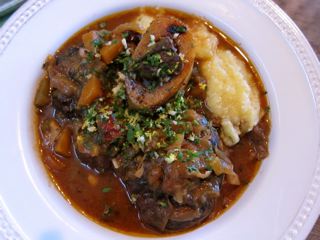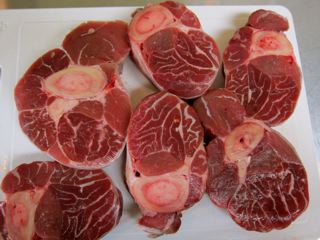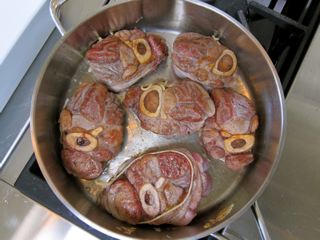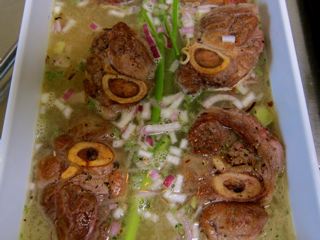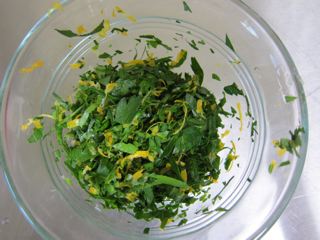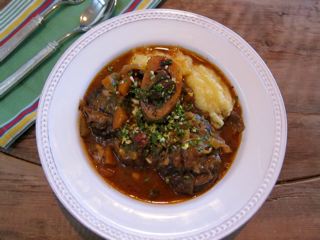Osso Bucco
Osso Bucco
For solace during the torrential March rains and shivery nights I turn toward northern Italy where long, cold winters are expected, and people warm themselves with hearty, bone-warming soups and stews.
Osso Bucco, a classic Real Food.
Most commonly identified with Milan, osso bucco translated is bone with a hole, and it refers to veal shank cut into thick rounds braised in white wine. Osso Bucco is a perfect example of recipes that evolve through generations of creative farm cooks using up all the edible parts of available food. Now it is served in the world-class restaurants using recipes finely honed by famous chefs.
What makes Osso Bucco unique is the round shank bone in the center of each cut of meat. A marrow bone, it adds marrow’s signature rich flavor and silken texture to the finished dish that makes it soar above pot roast or ordinary stews.
Because so many cooks and chefs have tweaked, modified and experimented with this great dish, recipes for Osso Bucco are a cinch to find. Among all of them there seem to be two primary divisions: with or without tomato. Almost all of the recipes call for Gremolata, a mixture of minced garlic, Italian parsley and lemon zest added in the last stage of cooking.
Finally, because it is braised in a liquid that creates lots of delicious sauce, most recipes suggest serving Osso Bucco with a sauce absorbing starch. In northern Italy the starch is risotto. Other commonly used starches include pasta, mashed potatoes and polenta, my preference.
I use a Mario Batali recipe modified to suit my own taste preferences. I have to tell you my mouth is watering even writing about Osso Bucco; my guess is be it will show up on my dinner table within a week..
Hints
- Traditionally Osso Bucco is made with cut veal shank but some meat departments label cut pieces of pork, beef or lamb shank as “Osso Bucco”. Be sure you know which meat you are getting. The marrowbone is obvious and makes or breaks the recipes.
- Veal, usually significantly more expensive than regular beef also provides a milder, more delicate flavor. I tried it with beef shank though, and it’s also really good.
- Shank cuts need to be thick (at least 2”, preferably 3”) for two reasons: first, to get enough bone marrow and second so the meat will hold together during the cooking process.
- Wrap the cuts with kitchen twine to insure that each portion holds together. Remove the twine before serving.
- Don’t let the process deter you from cooking Osso Buco. Prepping before you begin will take about 30 minutes. Most of the cooking happens in the oven and you don’t have to be there at all.
- I prefer browning the meat in a skillet, then transferring it to a baking pan to braise.
The browning also can be done in the oven, but it splatters grease that is hard to remove during “self cleaning”. Osso Bucco’s signature flavor comes from bone marrow, so I buy an extra set to cook along with the shank cuts, then add some to each shank when I add the Gremolata.
Osso Bucco
Serves 4
(The recipe credited to Mario Batali, came from The Food Network.) *indicate my modifications.
Ingredients
4 veal shanks cut 3” thick
Salt and pepper
½ cup potato flour*
4 large marrow bones*
6 tbs. extra virgin olive oil
2 carrots, chopped into ¼” rounds
1 medium Spanish onion, chopped*
3 cloves garlic, peeled and chopped*
1 celery stalk, chopped
3 tbs. fresh thyme leaves*
1 can (15oz.) diced tomato with puree*
2 cups chicken stock
2 cups Masala wine*
2 cups cooked polenta
Gremolata
Zest of one large lemon, 2 garlic cloves (peeled and minced), 2 tbs. Italian minced parsley, 1 tsp. extra virgin olive oil. Combine and season with salt and pepper.
Procedure
Preheat the oven to 375º. While it is heating, prepare the Osso Bucco.
- Season the shanks on both sides with salt and pepper. Sprinkle flour evenly over waxed paper and dredge shanks lightly on both sides.
- In a heavy skillet heat olive oil until smoking. Add shanks and brown on both sides. Transfer shanks to a baking pan. Place uncooked marrow bones around the shanks.
- Add carrot, onion, celery, garlic and thyme to skillet and cook over medium heat until onion and carrot are softened, about 10 minutes. Add tomato with puree and stir to mix.
- Pour the sauce over the shanks and marrow bones. Mix stock with wine and add to the shanks, mixing the juice with the sauce. The sauce and other liquid should almost reach the top of the shanks.
- Cover the baking pan with a lid if it has one or tightly fitting foil. Cook shanks for 2 ½ hours or until the meat is almost falling off the bone.
- When it is done, remove the foil and take the marrow bones out of the pan. Divide the Gremolata among the shanks and cover them. Let the shanks rest for 15 minutes.
- While they are resting, carefully remove the marrow from the extra bones with a dinner knife and set aside in 4 mounds.
To Serve: Place cooked polenta in deep plates or pasta bowls. Put a shank over the polenta and divide the marrow among the shanks, on top of the Gremolata. Ladle sauce from the baking pan around and over the sides of the shanks leaving the Gremolata and marrow without sauce.
Hint: If there is extra sauce, add stock to it and enjoy fabulous soup the next day.
